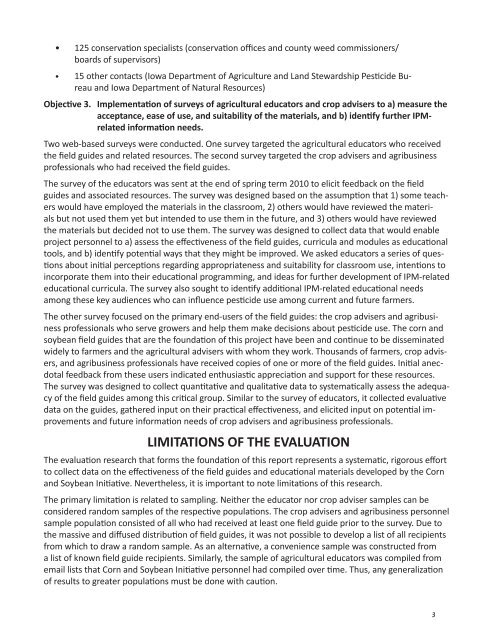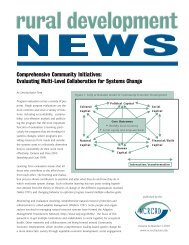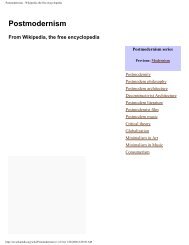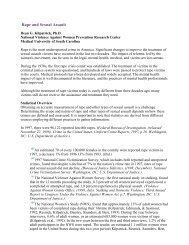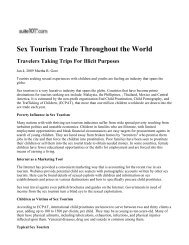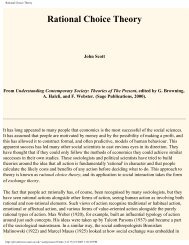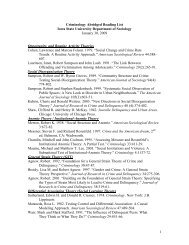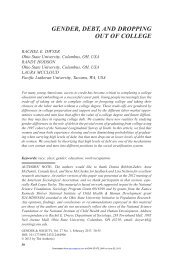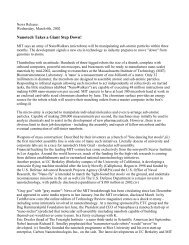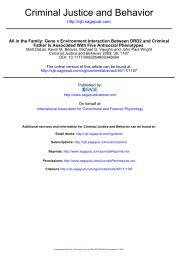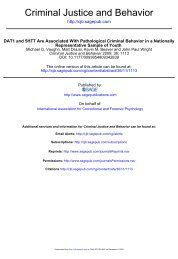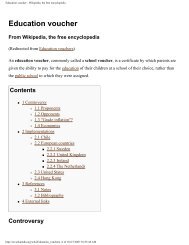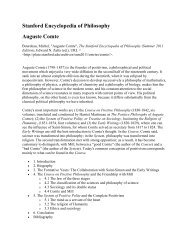Iowa State University Integrated Pest Management Field Guide ...
Iowa State University Integrated Pest Management Field Guide ...
Iowa State University Integrated Pest Management Field Guide ...
Create successful ePaper yourself
Turn your PDF publications into a flip-book with our unique Google optimized e-Paper software.
• 125 conservation specialists (conservation offices and county weed commissioners/<br />
boards of supervisors)<br />
• 15 other contacts (<strong>Iowa</strong> Department of Agriculture and Land Stewardship <strong>Pest</strong>icide Bureau<br />
and <strong>Iowa</strong> Department of Natural Resources)<br />
Objective 3. Implementation of surveys of agricultural educators and crop advisers to a) measure the<br />
acceptance, ease of use, and suitability of the materials, and b) identify further IPMrelated<br />
information needs.<br />
Two web-based surveys were conducted. One survey targeted the agricultural educators who received<br />
the field guides and related resources. The second survey targeted the crop advisers and agribusiness<br />
professionals who had received the field guides.<br />
The survey of the educators was sent at the end of spring term 2010 to elicit feedback on the field<br />
guides and associated resources. The survey was designed based on the assumption that 1) some teachers<br />
would have employed the materials in the classroom, 2) others would have reviewed the materials<br />
but not used them yet but intended to use them in the future, and 3) others would have reviewed<br />
the materials but decided not to use them. The survey was designed to collect data that would enable<br />
project personnel to a) assess the effectiveness of the field guides, curricula and modules as educational<br />
tools, and b) identify potential ways that they might be improved. We asked educators a series of questions<br />
about initial perceptions regarding appropriateness and suitability for classroom use, intentions to<br />
incorporate them into their educational programming, and ideas for further development of IPM-related<br />
educational curricula. The survey also sought to identify additional IPM-related educational needs<br />
among these key audiences who can influence pesticide use among current and future farmers.<br />
The other survey focused on the primary end-users of the field guides: the crop advisers and agribusiness<br />
professionals who serve growers and help them make decisions about pesticide use. The corn and<br />
soybean field guides that are the foundation of this project have been and continue to be disseminated<br />
widely to farmers and the agricultural advisers with whom they work. Thousands of farmers, crop advisers,<br />
and agribusiness professionals have received copies of one or more of the field guides. Initial anecdotal<br />
feedback from these users indicated enthusiastic appreciation and support for these resources.<br />
The survey was designed to collect quantitative and qualitative data to systematically assess the adequacy<br />
of the field guides among this critical group. Similar to the survey of educators, it collected evaluative<br />
data on the guides, gathered input on their practical effectiveness, and elicited input on potential improvements<br />
and future information needs of crop advisers and agribusiness professionals.<br />
LIMITATIONS OF THE EVALUATION<br />
The evaluation research that forms the foundation of this report represents a systematic, rigorous effort<br />
to collect data on the effectiveness of the field guides and educational materials developed by the Corn<br />
and Soybean Initiative. Nevertheless, it is important to note limitations of this research.<br />
The primary limitation is related to sampling. Neither the educator nor crop adviser samples can be<br />
considered random samples of the respective populations. The crop advisers and agribusiness personnel<br />
sample population consisted of all who had received at least one field guide prior to the survey. Due to<br />
the massive and diffused distribution of field guides, it was not possible to develop a list of all recipients<br />
from which to draw a random sample. As an alternative, a convenience sample was constructed from<br />
a list of known field guide recipients. Similarly, the sample of agricultural educators was compiled from<br />
email lists that Corn and Soybean Initiative personnel had compiled over time. Thus, any generalization<br />
of results to greater populations must be done with caution.<br />
3


